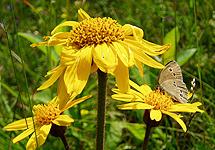HNV Farming & Biodiversity
Bucegi (Romania)

Natura site name: Bucegi
Natura Code: RO-SCI-0013
Mountain region with small-scale semi-substistence farming. Imortant aspects are the high level of biodiversity resulting from the high number of individual meadow parcels all managed in a subtly different way and with low-intensity. Also, the land-use system incorporates short-distance transhumance (or pendulation) during the summer months to mountain pastures.
Text: S. Huband & B. Hill
© Photos: S. Huband













